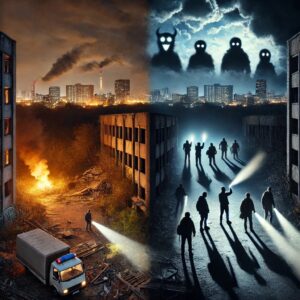Devil’s Night, the night before Halloween, has a notorious reputation for mischief, pranks, and even arson in certain cities. But how did this eerie tradition start, and why did it take such a dark turn in places like Detroit? To understand, we need to dive into a history filled with youthful rebellion, urban decay, and the thin line between harmless fun and dangerous chaos.
The origins of Devil’s Night can be traced back to early European traditions of “Mischief Night.” Dating back to the 18th century in the UK, the night before May Day or All Hallows’ Eve was set aside for harmless pranks like knocking on doors and hiding objects. The idea was simple: a night of playful trickery to balance the spooky solemnity of Halloween.
When immigrants brought their customs to the United States, Mischief Night became a part of the Halloween festivities. Kids would soap up windows, toilet-paper trees, and engage in relatively innocent pranks. It wasn’t about harm or destruction—just some fun before the candy collection on Halloween night.
However, in the mid-20th century, Devil’s Night took a darker turn, particularly in Detroit. As the city struggled with economic decline, racial tensions, and depopulation, the night became a symbol of deeper unrest. By the 1970s and 1980s, what had once been a night of harmless pranks morphed into something far more dangerous. Arson became rampant, with hundreds of abandoned buildings set on fire each year.
The media spotlight on Detroit’s Devil’s Night painted a bleak picture, and the city’s reputation was deeply affected. Authorities struggled to control the chaos, and for many, it was a sign of a city in crisis. While the fires symbolized a city’s decay, they also represented the anger and frustration of its residents. What had started as mischief became a desperate cry for attention.
By the 1990s, efforts were underway to take back Devil’s Night from the flames. Community leaders and volunteers started patrolling the streets, determined to prevent arson and vandalism. Detroit’s residents banded together in what became known as “Angel’s Night.” By reclaiming the night, they aimed to restore a sense of pride in their city. Slowly but surely, the number of fires declined, and Detroit began to shed the dark legacy of Devil’s Night.
Today, Devil’s Night still exists in the folklore of Halloween, but its destructive legacy is fading. The shift toward community activism, especially in Detroit, shows how a night of mischief can be transformed through collective action and a desire for change.
Devil’s Night is a reminder of how traditions can evolve, sometimes for the worse, and how communities can work together to reclaim what was lost. What started as playful pranks turned into something far more destructive, but through determination and unity, cities like Detroit have worked to rewrite the narrative. The history of Devil’s Night may be dark, but its transformation is a testament to the resilience of communities.

